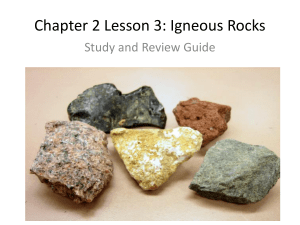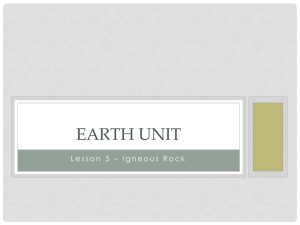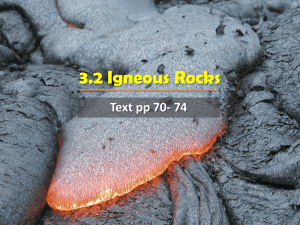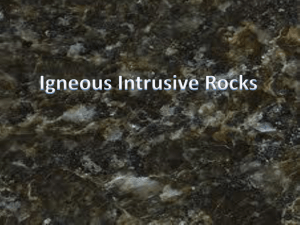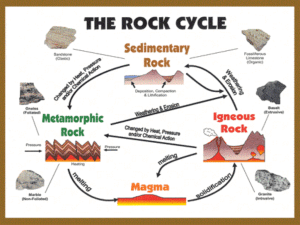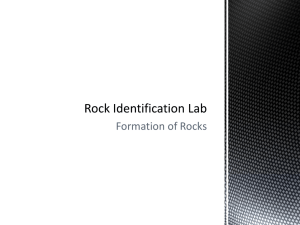Igneous rocks
advertisement
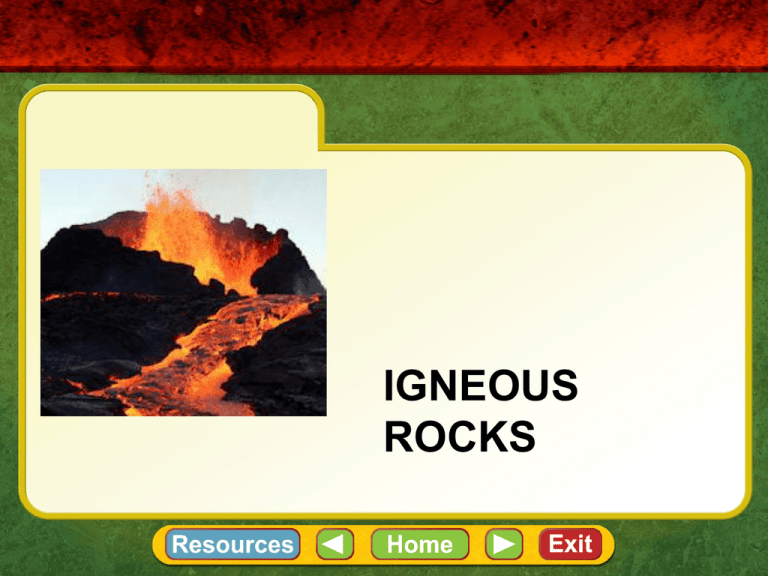
IGNEOUS ROCKS Video Quiz True or False? 1 Igneous rocks are still forming in fiery places today. 2 Weathering makes rocks harder. 3 Sediments harden into rock through lithification. 4 During metamorphism, limestone might change into marble 5 In the rock cycle, igneous, sedimentary and metamorphic rock can change into one another. CH 5 Igneous Rocks Section 5.1: What are igneous rocks? Section 5.2: Classification of Igneous Rocks CH Section 5.1 What are igneous rocks? Objectives Summarize igneous rock formation. Describe the composition of magma. Igneous rocks are the rocks that form when molten material cools and crystallizes. CH What are igneous rocks? Igneous Rock Formation Lava is magma that flows out onto Earth’s surface. Igneous rocks form when lava or magma cools and minerals crystallize. CH What are igneous rocks? Igneous Rock Formation Magma formation Magma can be formed either by melting of Earth’s crust or by melting within the mantle. CH • Draw and Label a volcano, lava, and magma. (in your workbook) CH CH What are igneous rocks? Igneous Rock Formation Magma formation The four main factors involved in the formation of magma are temperature, pressure, water content, and mineral content. CH What are igneous rocks? Magma formation Temperature generally increases with depth in Earth’s crust. This temperature increase is known as the geothermal gradient. How deep in Earth do you have to go to reach 1000°C? How hot is it at 3000km? FLASH CARDS 1. What is lava? 2. What is magma? CH Classification of Igneous Rocks Objectives Classify different types and textures of igneous rocks. Recognize the effects of cooling rates on the grain sizes in igneous rocks. CH Section 5.2 Classification of Igneous Rocks Classification of igneous rocks is based on mineral composition, crystal size, and texture. CH Classification of Igneous Rocks Where Igneous Rocks Form When magma cools and crystallizes below Earth’s surface, intrusive rocks form. Magma that cools and crystallizes on Earth’s surface forms extrusive rocks. CH CH Classification of Igneous Rocks Texture Texture refers to the size, shape, and distribution of the crystals or grains that make up a rock. We use texture to tell us if a rock was intrusive or extrusive. CH Section 5.2 Classification of Igneous Rocks Texture Crystal size and cooling rates Extrusive Rocks: •When lava flows on Earth’s surface, it cools QUICKLY. •Crystals are MICROSCOPIC CH Classification of Igneous Rocks Texture Crystal size and cooling rates Intrusive Rocks: •When magma cools slowly below Earth’s surface •Large crystals to form. CH Classification of Igneous Rocks Texture Porphyritic texture •large, well-formed crystals •surrounded by finergrained crystals of the same mineral or different minerals. CH Classification of Igneous Rocks Texture Vesicular texture •spongy appearance •results of gas bubbles trapped in lava FLASH CARDSGive 2 examples What is the of intrusive grain size of an igneous rocks. intrusive rock? What is the grain size of an extrusive rock? Give 2 examples of extrusive igneous rocks. How are intrusive igneous rocks formed? How are extrusive igneous rocks formed?

